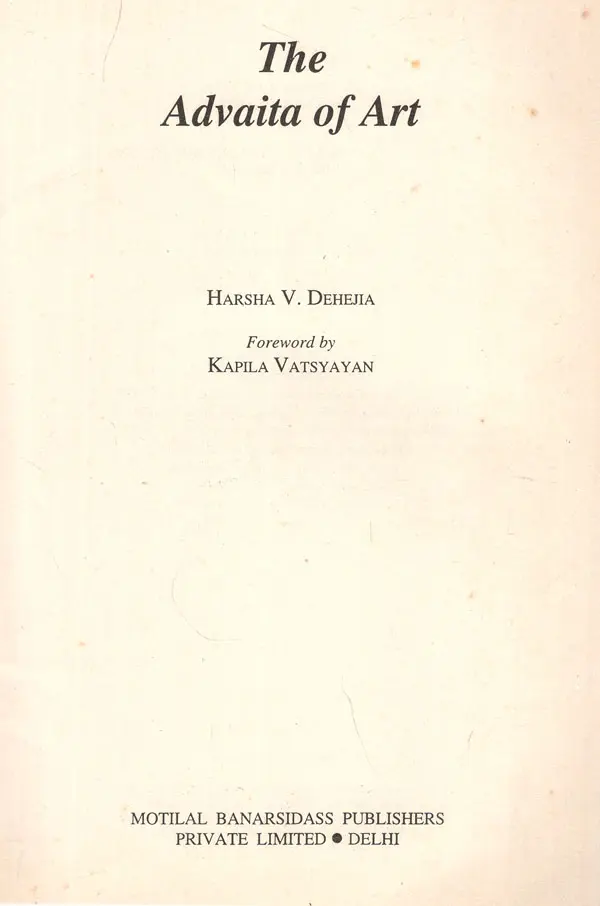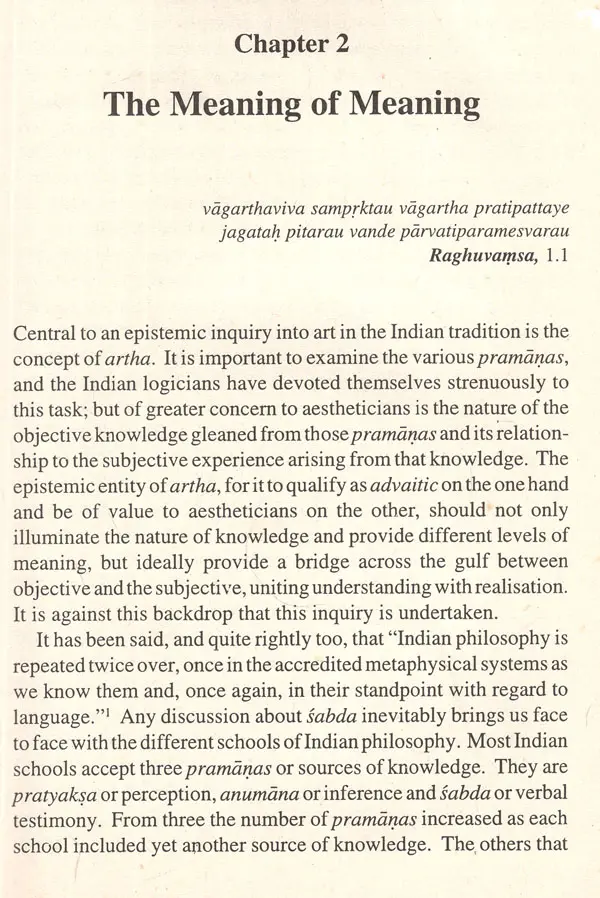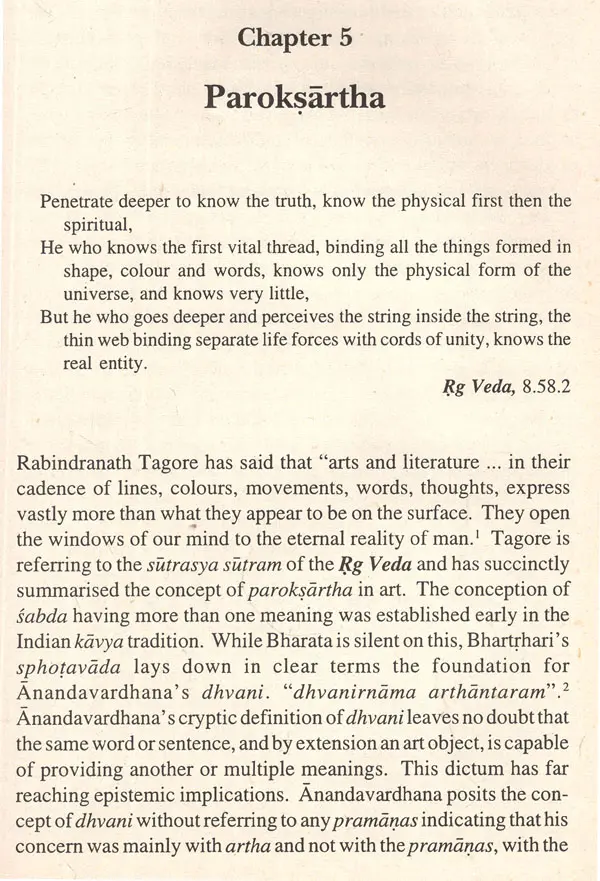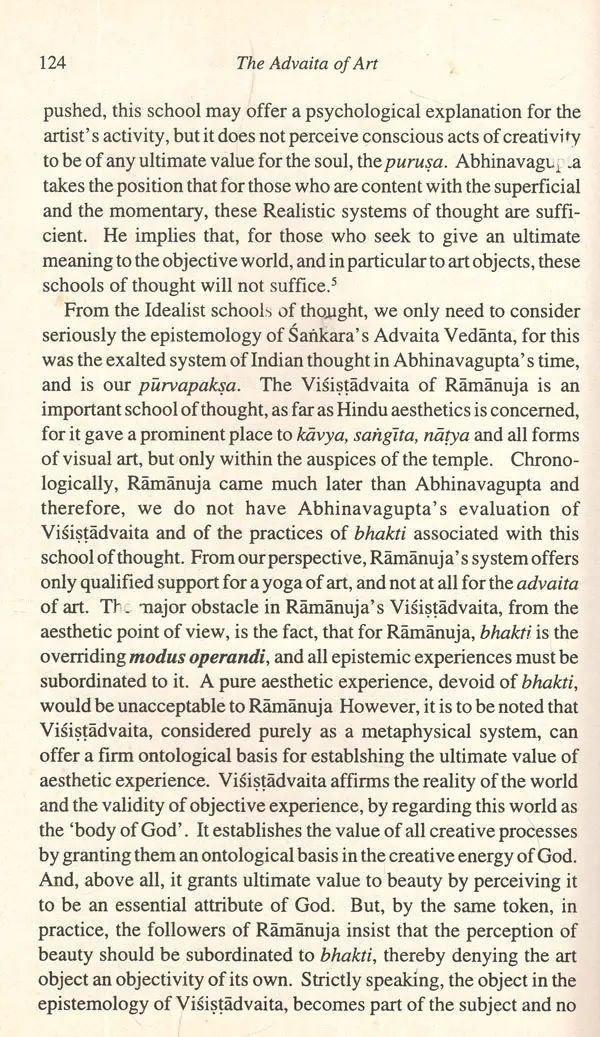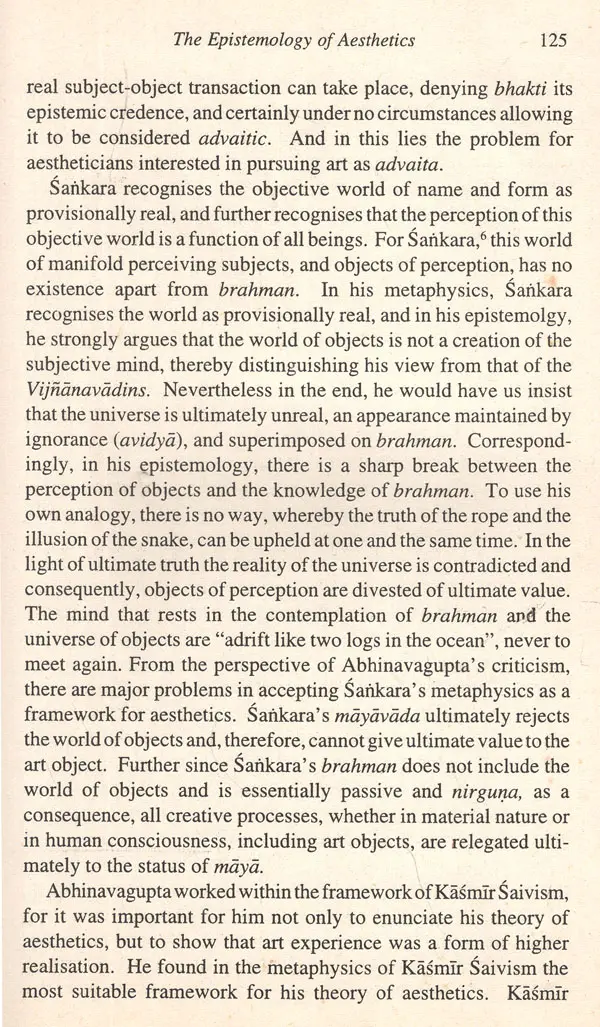
The Advaita of Art (An Old and Rare Book)
Book Specification
| Item Code: | UAK632 |
| Author: | Harsha V. Dehejia |
| Publisher: | MOTILAL BANARSIDAS PUBLISHERS PVT.LTD |
| Language: | English |
| Edition: | 1997 |
| ISBN: | 9788120813892 |
| Pages: | 194 |
| Cover: | PAPERBACK |
| Other Details | 8.50 X 5.50 inch |
| Weight | 280 gm |
Book Description
This inquiry is an undertaking to demonstrate that aesthetic experience in the classical Indian tradition, on its own merit, without being subordinated to rituals and practices commonly held under the rubric of religion, is capable of providing a transcendent experience to a prepared aesthete. Dr. Dehejia examines the dynamics of two aesthetic processes, that stemming from aesthetic emotion or rasa and from aesthetic form or rupa, and cogently underpins them within the advaitic epistemology of Kasmir Saivism. The advaita of art, Dr. Dehejia argues, is a joyous celebration of affirmation and assertion and not negation.
"...the book encompasses a staggering variety of primary and secondary sources and sets to investigate the aesthetic experience principally from the point of view of the aesthete...there is a wealth of material introspection and insight, a rare combination of the diagnostic skills of a physician and the artistic insights of an aesthete to survey a vast and continuously flowing stream of Indian aesthetics."-KAPILA VATSYAYAN.
Harsha V. Dehejia has a doctorate in Medicine and Ancient Indian Culture from Bombay University. He is also a member (by examination) of the Royal College of Physicians of London and Glasgow as well as Canada. He is a practising physician and Adjunct Professor in the Department of Religion of Carleton University in Ottawa, Ontario, Canada. He is married to Sudha and has two sons Vivek and Rajeev, both of whom are economists.
It is with much pleasure and some trepidation that I respond to Dr. Harsha V. Dehejia' s request to write a foreword to a book which encompasses a stagerring variety of primary and secondary sources and sets out to investigate the aesthetic experience principally from the point of view of the aesthete, the receiver, rather than, the creator or artist. This is, by any account a daunting task which could be undertaken only by one courageous and unconventional.
Dr. Dehejia begins by distinguishing between art and religion, making it clear that he does not propose to look at all that may be understood as ritual, indeed that path he bypasses by volition. Instead, his quest is to identify the process of realising transcendence through art, which he considers by and large secular. He adopts advaita as an epistemic concept for this exploration, and clearly uses the term in an unconventional way to investigate the oneness of art and aesthetic experience as also the progressive and sequential bond of the kavi (creator, artist), kavya (the art object) and rasika (the connoisseur, receiver). As almost a logical consequence he is obliged to probe deeply into the more fundamental concept of creativity and aesthetic experience as transcendency, as also the dynamics of the cognition and experience of art. For Dr. Dehejia there is an unbroken chain he calls advaitic, from creation to cognition and from cognition to realisation. Examination of the terms pratibha-kriya was natural, as also identification of the acausal' nature of the creative action. Although Dr. Dehejia' s principal or ultimate concern is with the rasika (aesthete, the receiver) he covers the entire gamut of the artistic process from the point of view of meaning, form, function and communication. The discourse on content, form and technique, word and meaning is perennial and worldwide. From Plato to Longinus and Plotinus and from Aristotle to Horace, from Greek to Romans, from the Romantics to the Modernists, there has been a sustained discourse. Fundamental to the discourse are ontological questions on what constitutes `reality' and what and how does the artist create a new universe. In India there has been a most refined and sopihisticated discourse, not only in texts of aesthetics, but also in those of speculative thought, be it the Vedas or the Upanisads or the six schools of philosophy and most of all Kasmir Saivism. Dr. Dehejia traverses this vast canvas of primary sources and also embraces the writings of Aurobindo, Rabindranath Tagore, Stella Kramrisch, Alice Boner and Niharranjan Ray and others. In short, his method is to investigate each concept through the principal primary texts, with a marked preference for texts of Kasmir Saivism and to juxtapose these with the intrepreters of the twentieth century. This interplay of the ancient and contemporary, the primary and secondary and tertiary sources, makes a fascinating puzzling journey which keeps the reader engaged.
In an unbroken tradition, from times pre-historic to the present, art has remained an integral part of Indian life, and has not only cut through social, religious and cultural barriers within the country, but has accompanied Indian trade and thought in their movement across the frontiers. The Indian tradition accords an exalted position to art and, significantly, holds both the artist and the aesthete in equal esteem. Historically speaking, art and aesthetics in India have interacted with social, political and cultural factors, and in every age have produced their own artists and astheticians, who while carrying the tradition within them, have reacted to situations that prevailed in their age. The turn of this century was an axial period in the history of art and aesthetics in modern India. It was a period when Indian artists and aestheticians were reacting to Western ideas and counter-reacting to Western interpretations of Indian art; it was a time of a modern Indian artistic renaissance when, after long years of colonialisation, Indians were rediscovering themselves; it was an era of self-discovery and self-affirmation. Ananda Kentish Coomaraswamy was one such modern aesthetician and it was he who brought into focus, "... the important part once played in Indian thought by the concept of Art as Yoga, a subject sufficient in itself for a whole volume."
Coomaraswamy was one of the first modern aestheticians, of the Indian sub-continent, to have used the phrase "yoga of art", and the present inquiry owes its inspiration in a large measure to that statement. The concept of art as yoga not only exalts art, suggests its autonomous and non-sectarian position but at the same time points out the possibility of ensuring aesthetic experience a transcendency and that too within the framework of advaita. Coomaraswamy was a pioneer who drew attention to certain deeper, and more fundamental epistemic aspects of art and aesthetic experience, features that have been present all along in the ancient Indian tradition but which were probably being forgotten by early twentieth century art critics in India. Art involves equally the artist and the aesthete, and an examination of art must include both the creation and the appreciation of art. However, the focus of this inquiry is the aesthete rather than the artist. While the artist occupies an exalted position in the Indian tradition, the aesthete is charged with an equally heavy responsibility. Art in the Indian tradition is not merely ornamental or decorative, not just an idle pastime or sport, not an outpouring of a superficial state of mind; and the aesthete in turn was not a mere spectator or voyeur but one who was expected to apply himself seriously and deliberately in the enjoyment and understanding of art.
**Contents and Sample Pages**
